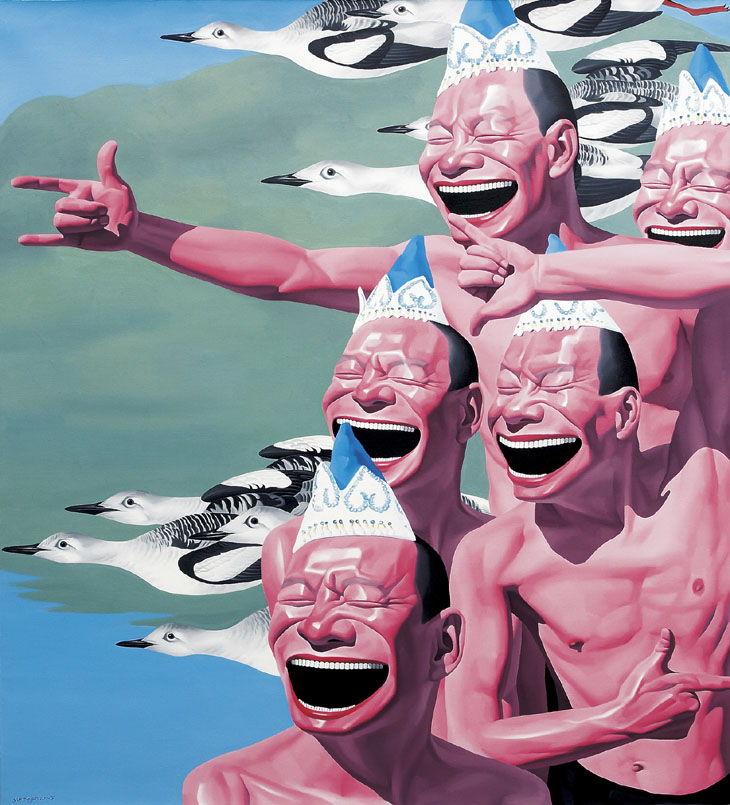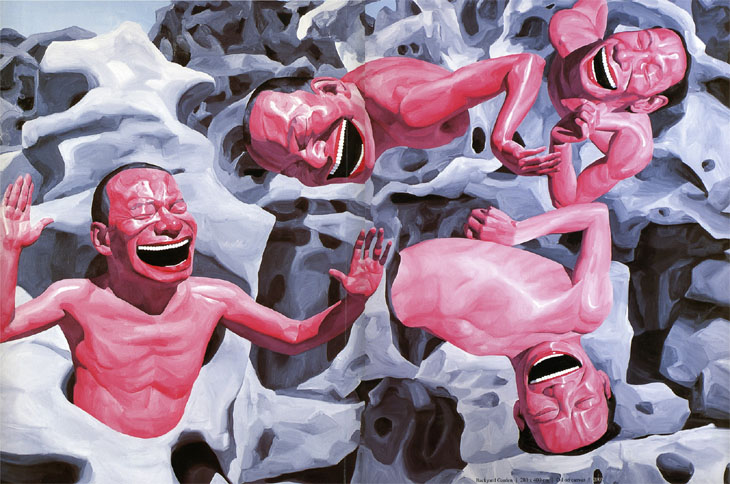

ARTIST:
Yue Minjun
Immediately humorous and sympathetic, Yue Minjun’s paintings offer a light-hearted approach to philosophical enquiry and contemplation of existence. Drawing connotations to the disparate images of the Laughing Buddha and the inane gap toothed grin of Alfred E. Newman, Yue’s self-portraits have been describe by theorist Li Xianting as “a self-ironic response to the spiritual vacuum and folly of modern-day China.â€
Often basing his compositions on well known European masterpieces and iconic Chinese art, Yue subverts the grandiose aura of art history through his adaptation of pop aesthetics. Using both the exaggerated expressiveness of cartooning and the stylistic rendering of graphic illustration, Yue depicts his cloned doppelgangers as contorted and grotesque, all scalded pink skin and maniacal toothy cackles.
The acidic tones and commercialised vacuity of his works are used to underscore the insincerity of his figures’ mirth. As both antagonists and anti-heroes, Yue’s hysterical cohorts equally bully the viewer and stand as subjects of ridicule. Using laughter as a denotation of violence and vulnerability, Yue’s paintings balance a zeitgeist of modern day anxiety with an Eastern philosophical ethos, positing the response to the Immediately humorous and sympathetic, Yue Minjun’s paintings offer a light-hearted approach to philosophical enquiry and contemplation of existence. Drawing connotations to the disparate images of the Laughing Buddha and the inane gap toothed grin of Alfred E. Newman, Yue’s self-portraits have been describe by theorist Li Xianting as “a self-ironic response to the spiritual vacuum and folly of modern-day China.â€
Often basing his compositions on well known European masterpieces and iconic Chinese art, Yue subverts the grandiose aura of art history through his adaptation of pop aesthetics. Using both the exaggerated expressiveness of cartooning and the stylistic rendering of graphic illustration, Yue depicts his cloned doppelgangers as contorted and grotesque, all scalded pink skin and maniacal toothy cackles.
The acidic tones and commercialised vacuity of his works are used to underscore the insincerity of his figures’ mirth. As both antagonists and anti-heroes, Yue’s hysterical cohorts equally bully the viewer and stand as subjects of ridicule. Using laughter as a denotation of violence and vulnerability, Yue’s paintings balance a zeitgeist of modern day anxiety with an Eastern philosophical ethos, positing the response to the true nature of reality as an endless cynical guffaw.
Often basing his compositions on well known European masterpieces and iconic Chinese art, Yue subverts the grandiose aura of art history through his adaptation of pop aesthetics. Using both the exaggerated expressiveness of cartooning and the stylistic rendering of graphic illustration, Yue depicts his cloned doppelgangers as contorted and grotesque, all scalded pink skin and maniacal toothy cackles.
The acidic tones and commercialised vacuity of his works are used to underscore the insincerity of his figures’ mirth. As both antagonists and anti-heroes, Yue’s hysterical cohorts equally bully the viewer and stand as subjects of ridicule. Using laughter as a denotation of violence and vulnerability, Yue’s paintings balance a zeitgeist of modern day anxiety with an Eastern philosophical ethos, positing the response to the Immediately humorous and sympathetic, Yue Minjun’s paintings offer a light-hearted approach to philosophical enquiry and contemplation of existence. Drawing connotations to the disparate images of the Laughing Buddha and the inane gap toothed grin of Alfred E. Newman, Yue’s self-portraits have been describe by theorist Li Xianting as “a self-ironic response to the spiritual vacuum and folly of modern-day China.â€
Often basing his compositions on well known European masterpieces and iconic Chinese art, Yue subverts the grandiose aura of art history through his adaptation of pop aesthetics. Using both the exaggerated expressiveness of cartooning and the stylistic rendering of graphic illustration, Yue depicts his cloned doppelgangers as contorted and grotesque, all scalded pink skin and maniacal toothy cackles.
The acidic tones and commercialised vacuity of his works are used to underscore the insincerity of his figures’ mirth. As both antagonists and anti-heroes, Yue’s hysterical cohorts equally bully the viewer and stand as subjects of ridicule. Using laughter as a denotation of violence and vulnerability, Yue’s paintings balance a zeitgeist of modern day anxiety with an Eastern philosophical ethos, positing the response to the true nature of reality as an endless cynical guffaw.

